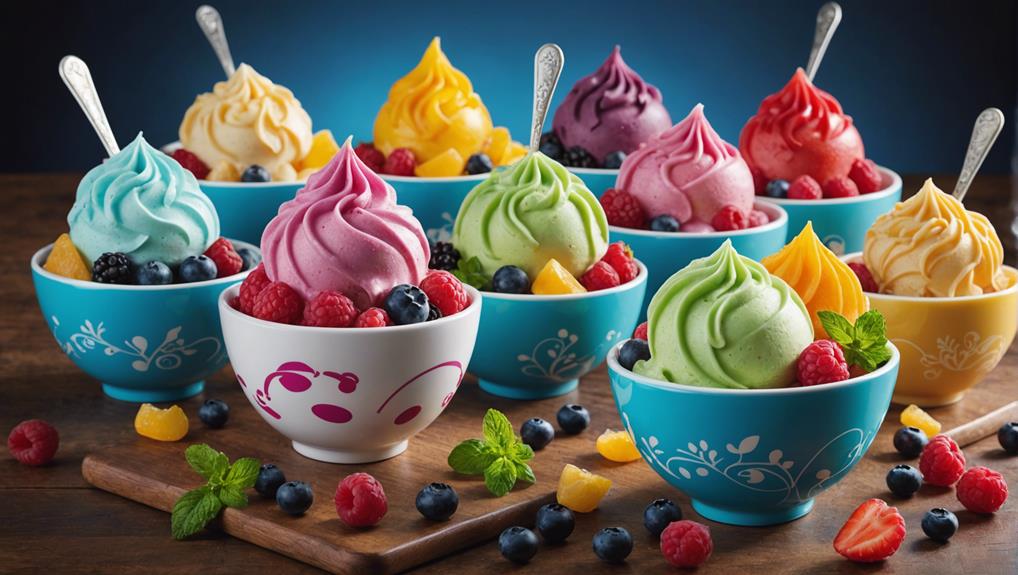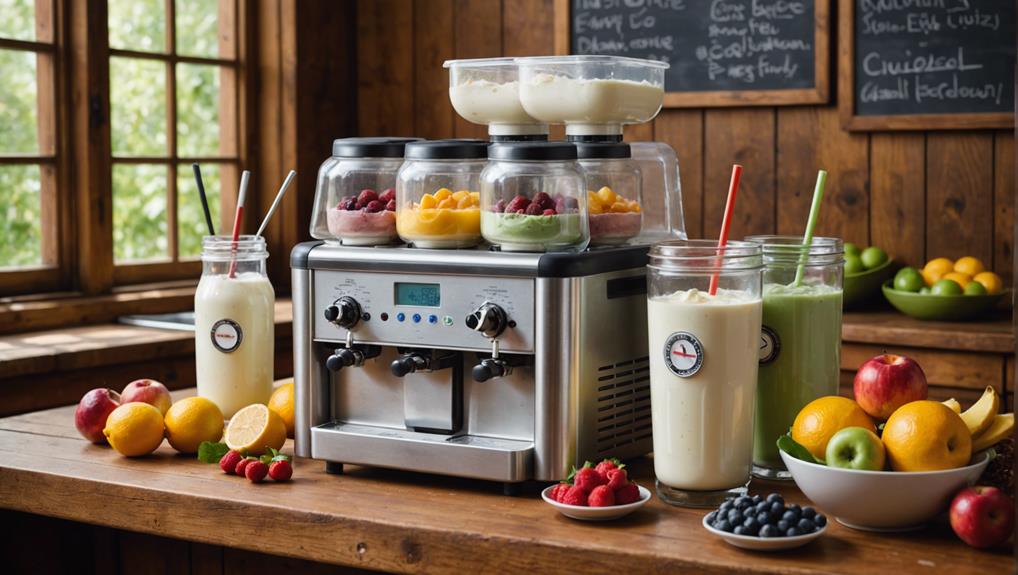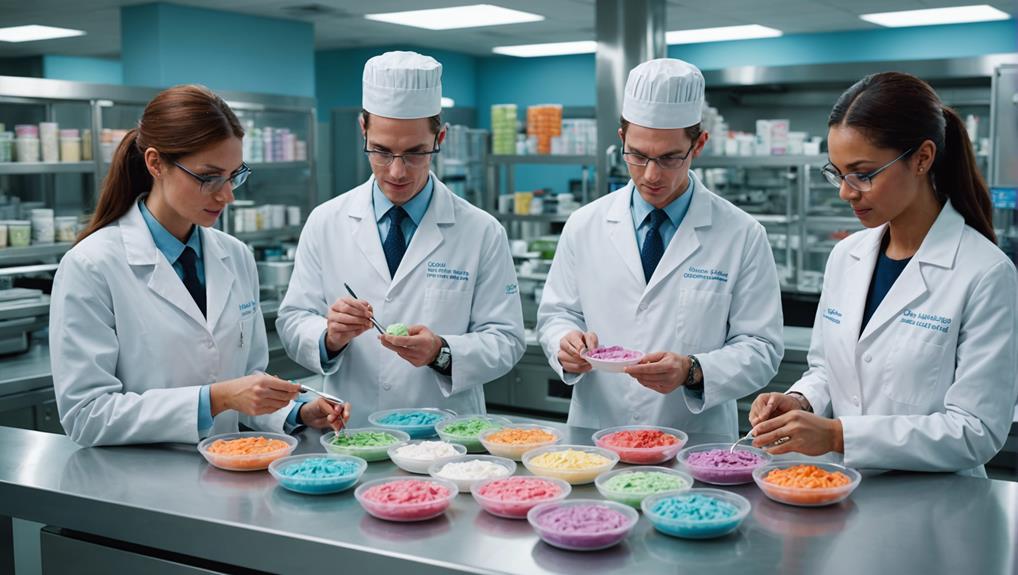Stabilizers and emulsifiers play a crucial role in frozen yogurt production by enhancing texture, consistency, and shelf life. Stabilizers like guar gum, locust bean gum, and xanthan gum improve viscosity, prevent ice crystal growth, and elevate the product’s overall mouthfeel. Emulsifiers such as soy lecithin, mono and diglycerides, and polysorbate 80 guarantee even fat dispersion and mitigate ice recrystallization, resulting in a smoother, creamier consistency. These components work synergistically to bind free water, prevent fat-water separation, and extend the product’s shelf life. For a deeper understanding of their intricate roles and benefits, the details follow.
Key Takeaways
- Stabilizers like guar gum and carrageenan prevent ice crystal growth for a smoother texture in frozen yogurt.
- Emulsifiers such as soy lecithin ensure even fat distribution, maintaining a stable and creamy consistency.
- Stabilizers and emulsifiers work together to extend shelf life by preventing ingredient separation and controlling melting.
- Polysaccharides in stabilizers enhance viscosity, improving the body and mouthfeel of frozen yogurt.
- Emulsifiers like mono and diglycerides streamline production, contributing to a consistent and high-quality product.
Role of Stabilizers

Stabilizers in frozen yogurt play a pivotal role in enhancing viscosity, thereby contributing to a smoother and more consistent texture. In the ice cream industry, stabilizers are paramount for improving the body and texture of the final product. Commonly used stabilizers, such as guar gum and carob bean gum, are effective in preventing ice crystal growth, which is vital for maintaining the desired creaminess and stability of frozen yogurt.
The primary function of stabilizers is to reduce the size and formation of ice crystals during the freezing process. This is achieved by increasing the viscosity of the yogurt mixture, which in turn inhibits the mobility of water molecules, thereby reducing ice formation. By controlling ice crystal growth, stabilizers ensure a more uniform and appealing texture, which is highly valued in the ice cream industry.
Additionally, stabilizers extend the shelf life of frozen yogurt by maintaining its structural integrity over time. The prevention of large ice crystals not only enhances the sensory attributes but also guarantees a stable product during storage and distribution. Proper use of stabilizers is hence indispensable for producing a high-quality frozen yogurt with consistent texture and prolonged shelf stability.
Role of Emulsifiers
Emulsifiers, like soy lecithin and mono and diglycerides, play an essential role in frozen yogurt production by ensuring the even dispersion of fat molecules, thereby maintaining a smooth and stable texture. These compounds are integral in achieving the desired consistency and mouthfeel in frozen desserts, as they prevent the separation of ingredients within the ice cream mix. The neutral taste of soy lecithin makes it particularly suitable for this application, ensuring that the flavor profile of the frozen yogurt remains unaffected.
One of the primary functions of emulsifiers in frozen yogurt is to mitigate ice recrystallization. This aspect is important for maintaining the creamy texture and preventing the formation of large ice crystals, which can degrade the consumer experience. Additionally, emulsifiers work synergistically with stabilizers and emulsifiers like locust bean gum and gelling agents to enhance product stability and texture.
| Emulsifier | Function | Impact on Frozen Yogurt |
|---|---|---|
| Soy Lecithin | Fat Dispersion | Smooth Texture |
| Mono and Diglycerides | Ice Recrystallization | Creamy Consistency |
| Locust Bean Gum | Stabilization | Enhanced Mouthfeel |
| Gelling Agents | Structure Formation | Consistent Texture |
Common Types of Stabilizers

Building on the foundational role of emulsifiers, the incorporation of stabilizers such as guar gum, locust bean gum, xanthan gum, and carrageenan is crucial for enhancing the textural integrity and stability of frozen yogurt. Guar gum, derived from the guar plant, is pivotal in this scenario due to its exceptional ability to boost texture and inhibit the growth of ice crystals. This polysaccharide functions by increasing the viscosity of the liquid phase, thereby limiting the mobility of water molecules and reducing the formation of ice crystals, which is essential for maintaining a smooth and creamy consistency in frozen yogurt, akin to that of premium ice cream.
Locust bean gum, another polysaccharide, synergizes with other stabilizers to further refine the texture and mouthfeel of the final product. Its role in creating a smooth and creamy consistency is well-documented, particularly in combination with xanthan gum, which augments the overall stability and mouthfeel. Xanthan gum, often utilized in tandem with other stabilizers, enhances viscosity and consistency, contributing significantly to the product’s structural integrity.
Carrageenan, a versatile stabilizer derived from red seaweed, is instrumental in maintaining the structure and texture of frozen yogurt. Its ability to interact with milk proteins ensures uniformity and prevents phase separation, thereby optimizing the overall quality of the frozen dessert.
Common Types of Emulsifiers
In the formulation of frozen yogurt, soy lecithin, Mono and Diglycerides, and Polysorbate 80 serve as pivotal emulsifiers, each contributing uniquely to the product’s texture and stability. Soy lecithin, a neutral-tasting emulsifier, is particularly effective in recipes that exclude egg yolks, guaranteeing homogeneous fat distribution. Mono and Diglycerides are essential for their ability to streamline production by eliminating the need for a custard base, thereby reducing both time and cost.
Polysorbate 80 is indispensable for its superior emulsification properties, which maintain the creaminess of frozen yogurt. When emulsifiers are combined with stabilizers such as cellulose gum, Sodium alginate, and carob bean gum, they synergistically enhance the overall quality of the product. These stabilizers are used to prevent ice crystal formation, a common issue in low-fat frozen desserts.
The integration of emulsifiers with stabilizers like cellulose gum and Sodium alginate ensures a smooth, consistent texture, a good thing for both consumer satisfaction and shelf stability. Carob bean gum, in particular, works well with emulsifiers to provide a creamy mouthfeel without the addition of excess cream, meeting consumer demand for healthier options without compromising sensory attributes.
Benefits in Frozen Yogurt

Utilizing stabilizers and emulsifiers in frozen yogurt formulation offers multifaceted benefits, including the reduction of ice crystal formation, which is critical for achieving a smoother and more desirable texture. Stabilizers such as guar gum and bean gum effectively bind free water, minimizing the growth of ice crystals during the freezing process. This action is essential to maintaining a consistent, creamy texture, even after prolonged storage.
Moreover, emulsifiers like soy lecithin and Mono and Diglycerides play a pivotal role in maintaining the structural integrity of frozen yogurt. These compounds prevent the separation of fat and water phases, thereby obviating the need for egg yolks and enhancing the overall stability of the product. By facilitating a uniform distribution of fat globules, emulsifiers contribute to a finer mouthfeel and improved flavor release.
In addition to textural improvements, the controlled melting properties imparted by stabilizers and emulsifiers extend the shelf life of frozen yogurt. This is particularly advantageous for commercial products that require prolonged storage without compromising quality. Collectively, the judicious selection and application of these additives elevate the sensory attributes, consistency, and durability of frozen yogurt, ultimately enhancing consumer satisfaction.
Frequently Asked Questions
What Are the Stabilizers in Frozen Yogurt?
Common stabilizers in frozen yogurt are natural gums like guar gum, carrageenan, and locust bean gum. These gelatin alternatives, used in stabilizer blends, are essential for ingredient sourcing, advanced production techniques, and achieving clean label standards.
What Are the Benefits of Using Stabilizers and Emulsifiers in Frozen Desserts?
Like a maestro conducting a symphony, stabilizers and emulsifiers harmonize frozen desserts by guaranteeing texture improvement, enhancing flavor retention, and extending shelf life. They secure smooth consistency, creamy mouthfeel, and reduce ice crystals, resulting in superior quality.
What Is the Purpose of Adding Emulsifiers and Stabilizers When Making Ice Cream?
The purpose of adding emulsifiers and stabilizers in ice cream is to enhance texture improvement, provide smooth consistency, aid in fat reduction, prevent ice crystallization, improve mouth feel, and guarantee efficient ingredient blending.
What Is the Difference Between Emulsifiers and Stabilizers in Ice Cream?
Emulsifiers enhance ingredient interactions and dairy compatibility by maintaining homogenous mixtures, while stabilizers improve texture, flavor retention, and thaw stability through their unique chemical properties, providing firm texture and preventing ice crystal formation in ice cream.
Conclusion
The interplay of stabilizers and emulsifiers in frozen yogurt plays a vital role in achieving the desired texture and stability. Stabilizers prevent ice crystal formation, while emulsifiers guarantee a uniform mixture of water and fat. For example, a study on the use of guar gum (stabilizer) and lecithin (emulsifier) demonstrated significant improvements in mouthfeel and shelf-life. This evidence underscores the necessity of these additives in producing high-quality frozen yogurt, thereby reinforcing their importance in the food processing industry.







